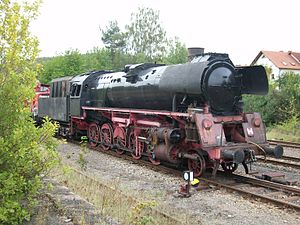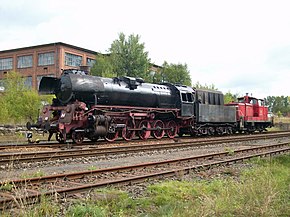DR series 50.40
| DR series 50.40 | |
|---|---|
|
50 4073 (2008)
|
|
| Numbering: | 50 4001-4088 |
| Number: | 88 |
| Manufacturer: | Lokomotivbau Karl Marx Babelsberg |
| Year of construction (s): | 1956-1960 |
| Retirement: | 1980 |
| Type : | 1'E h2 |
| Genre : | G56.15 |
| Gauge : | 1435 mm ( standard gauge ) |
| Length over buffers: | 22 600 mm |
| Empty mass: | 77.1 t |
| Service mass: | 85.9 t |
| Service mass with tender: | 149.4 t (with 2'2 'T 28 and full stocks) |
| Friction mass: | 73.4 t |
| Wheel set mass : | 14.7 t |
| Top speed: | 80 km / h (tender ahead operationally 50 km / h)) |
| Indexed performance : | 1294 kW / 1760 PSi |
| Starting tractive effort: | ~ 214 kN |
| Coupling wheel diameter: | 1400 mm |
| Impeller diameter front: | 850 mm |
| Control type : | Heusinger with hanging iron |
| Number of cylinders: | 2 |
| Cylinder diameter: | 600 mm |
| Piston stroke: | 660 mm |
| Boiler overpressure: | 16 bar |
| Number of heating pipes: | 150 |
| Number of smoke tubes: | 38 |
| Heating pipe length: | 4200 mm |
| Grate area: | 3.71 m² |
| Radiant heating surface: | 17.9 m² |
| Tubular heating surface: | 141.7 m² |
| Superheater area : | 68.50 m² |
| Evaporation heating surface: | 159.60 m² |
| Tender: | 2'2 'T 28 |
| Water supply: | 28 m³ |
| Fuel supply: | 10 tons of coal |
| Train heating: | steam |
The class 50.40 locomotives were newly built freight locomotives for the Deutsche Reichsbahn and a further development of the class 50 DR standard steam locomotives .
history
The German Reichsbahn had after the Second World War, about 350 locomotives of the series 50. However, the Reichsbahn needed further freight locomotives, the power range between the Series 50 and 52 and the heavy freight locomotives of class 44 should cover. At first the DR thought of building a 1'E h2 locomotive with a tender with an axle mass of 18 t. A survey in all Reichsbahn directorates showed, however, that only the Halle and Erfurt directorates gave preference to a machine with 18 t axle drive mass over a universally usable design with 15 t. The then Minister of Transport, Erwin Kramer , put an end to this . He ordered the procurement of a 1'E h2 with 15 t axle mass. Of the type now known as the 50.40 series, 350 pieces were initially to be procured. The aim was to add the new machines to the series 50 and replace some of the war locomotives and country series. In order to keep procurement and construction costs as low as possible, numerous assemblies of the 50.40 were taken over from the 23.10 series passenger locomotive, which was developed at the same time . Both series had the same boiler, the same driver's cab and the new type 2'2 'T28.
construction
The dimensions of the chassis largely corresponded to those of the standard locomotive series 50 and 52. The sheet metal frame used was a new design. Although it was stiffened several times in the longitudinal and transverse directions, it was designed too weakly for the tensile loads later required by the machines. Despite recommendations from the FVA Halle (vehicle testing facility , later VES-M Halle ), the framework has not been fundamentally revised. The result was considerable maintenance problems, which ultimately led to the relatively early withdrawal of the locomotives from the DR fleet.
The boiler was also a new construction based on modern building principles with a combustion chamber and mixing preheater. It was identical to that of the 23.10 series. The output of the new boiler was around 110 kW (150 hp) higher than that of the standard 50 series boiler. The new locomotives also performed better in terms of steam and coal consumption. All series machines were equipped with pressure compensation piston valves of the Trofimoff type, which impressed with their very good idling properties. The locomotives received the new tender of the type 2'2 'T 28, which was later coupled with locomotives of the series 50.35 and 58.30.
commitment
Contrary to the initial plans, only 88 machines, designated as 50 4001 to 4088, could be put into service between 1956 and 1960. With the 50 4088 delivered on December 30, 1960, not only the new steam locomotive construction program of the DR ended, but also the construction of standard gauge steam locomotives in Germany. The Deutsche Reichsbahn concentrated the machines in the Reichsbahn divisions Greifswald and Schwerin . From 1968 only the Rbd Schwerin locomotives of the 50.40 series were in use. Strongholds for this series were the depot Hagenow Land , from where they also Bundesbahn - border station Büchen reached, and the railway depot Wittenberge . After less than 20 years of service, the last 50.40 was retired in November 1980. Some machines were still used as steam dispensers and heating locomotives in various industrial companies.
Whereabouts
The Bavarian Railway Museum in Nördlingen has with the 50 4073 the only remaining machine of this series and the last construction lot of 80 aircraft in its inventory. With it, the last machine procured by a German state railway has been preserved (corresponding to the 23 105 on the DB , built in 1959). No locomotive made it onto the list of traditional locomotives of the Deutsche Reichsbahn . Originally the DR planned to keep the 50 4088 as the DR's last new steam locomotive. The machine was badly damaged in an accident in March 1980 and could no longer be used in operations. Although there were alternatives to the 50 4088, none of this series made it into the DR's traditional locomotive inventory.
See also
literature
- Dirk Endisch: Class 50.40: The new 50s of the Deutsche Reichsbahn . Verlag Dirk Endisch, Stendal 2010, ISBN 978-3-936893-50-2 .
Web links
Individual evidence
- ^ Bavarian Railway Museum : Steam locomotives. Retrieved September 21, 2017 .

